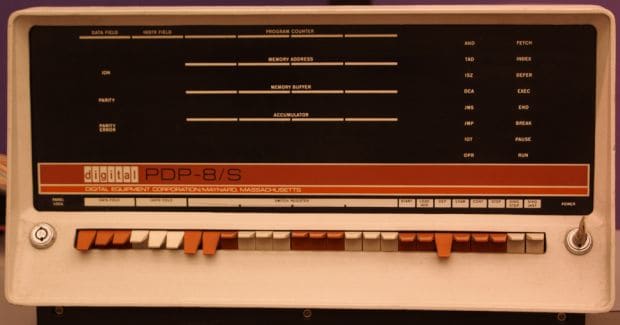Born of war and raised on mainframes, computer music comes of age in the 1970s and hits the charts thanks to the sampler.

PDP 8/S computer similar to that used by Peter Zinovieff at EMS. Photo: Jamie Cox
In this episode...
Alan Turing's Universal Machine;
Sydney's CSIRAC computer and its loudspeaker that clicked! [See ERRATUM below];
Max Mathews and his computer programme ‘Music’;
Early days of computer music: John Chowning, Suzanne Ciani and Barry Vercoe talk about their experiences waiting days to hear a split second of music;
The work at IRCAM in Paris;
Barry Vercoe’s music programming environment ‘Csound’;
John Chowning develops FM synthesis, a new way of making sound;
The Yamaha DX7, the biggest-selling synthesiser ever;
Peter Vogel and the Fairlight CMI;
By the 80s, computer-based music becomes affordable with the sampler.
Explore more of These Hopeful Machines
Written and presented by James Gardner, produced by Tim Dodd and James Gardner.
Scroll down for handy links and a bibliography.
Dedication
These Hopeful Machines: Episode 5 is dedicated to the British composer Tim Souster, who, in 1980 wrote and presented a programme about computer music for BBC Radio 3 called 'The Sleeping Giant Awakes' which, James Gardner says, “certainly fired my imagination.” Tim Souster died in 1994, but there is a website dedicated to this overlooked figure.
Grateful thanks for help in the production of this episode go to:
John Chowning, for the interview and for the early FM demonstrations from his own archive; Suzanne Ciani;
David Cockerell; Paul Doornbusch of Collarts in Melbourne for allowing us to use the excerpt of his interview with Miller Puckette; Barry Vercoe; Peter Vogel, for the interview and the loan of his copy of the Village Recorders Fairlight demo reel, which was restored and digitized by Sound Archives Ngā Taonga Kōrero in Christchurch in 2010; Peter Zinovieff.
Erratum
Since the production of this programme, evidence has come to light that refutes the assertion that CSIRAC was the first computer to have been programmed to produce musical sounds. At least two computers can claim precedence: the 'Manchester Electronic Computer Mark II'; and the Eckert-Mauchly 'BINAC' (BINary Automatic Computer).
While CSIRAC is known to have played tunes at least as early as August 1951, Christopher Strachey programmed the Manchester Mk II to play 'God Save The King' during the summer of 1951, and BINAC is documented as playing tunes in summer 1949. CSIRAC first stirred into life several months later, in about November 1949.
A detailed discussion of all this may be found in Jack Copeland and Jason Long's chapter 'Computer Music', pp. 233–248 of 'The Turing Guide' by Copeland, Bowen, Sprevak, Wilson et al., Oxford University Press 2017.
Copeland and Long's account of their restoration of a 1951 BBC recording of the Manchester Mk II playing music may be found here. And the restored recording is here.
Links
- Alan Turing
- Australia's CSIRAC computer
- Max Mathews on his programme MUSIC I
- Max Mathews and John Chowing in conversation with Curtis Roads
- John Chowning Interview
- Dave Bristow on the History of Yamaha FM Synthesizers
- Barry Vercoe interview
- Barry Vercoe and Laurence Beauregard at IRCAM in 1984
- Score-following history at IRCAM
- Pathé News clip of Peter Zinovieff’s Putney studio c. January 1968
- Miller Puckette interviewed by Paul Doornbusch
- Miller Puckette talking on Computer Instrument design
- Peter Vogel demonstrates The Fairlight on ‘This Week’ 1980
- Fairlight Instruments now
- Jon Leidecker's excellent Variations series, looking at "appropriative collage"
Bibliography
Nick Collins
Introduction to Computer Music
Wiley 2010
http://au.wiley.com/WileyCDA/WileyTitle/productCd-EHEP000962.html
Roger T. Dean (ed.)
The Oxford Handbook of Computer Music
Oxford University Press 2011
https://global.oup.com/academic/product/the-oxford-handbook-of-computer-music-9780199792030?q=The%20Oxford%20Handbook%20of%20Computer%20Music&lang=en
Curtis Roads
The Computer Music Tutorial
MIT Press 1996
http://mitpress.mit.edu/books/computer-music-tutorial
Paul Doornbusch
The Music of CSIRAC: Australia’s first Computer Music
Common Ground 2005
http://www.doornbusch.net/CSIRAC/
Jack Copeland, Jonathan Bowen, Mark Sprevak, Robin Wilson et al.
The Turing Guide
Oxford University Press 2017
https://global.oup.com/academic/product/the-turing-guide-9780198747833?lang=en&cc=us
Andrew Hodges
Alan Turing: The Enigma (centenary edition)
Vintage books 2012
http://www.turing.org.uk/book/

